

How to Teach Tricky Words - They Don't Have to be Tricky! Phonics Hero. By Shirley Houston on 26 Mar 2019 Using letter-sound correspondences is the most reliable strategy for spelling and reading words, however, there are times when a student will come upon ‘tricky words’ and cannot rely on this strategy.
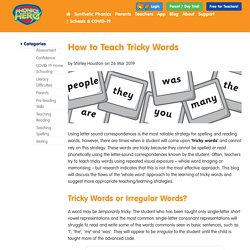
These words are tricky because they cannot be spelled or read phonetically using the letter-sound correspondences known by the student. Often, teachers try to teach tricky words using repeated visual exposure – whole word imaging or memorising – but research indicates that this is not the most effective approach. This blog will discuss the flaws of the ‘whole word’ approach to the learning of tricky words and suggest more appropriate teaching/learning strategies.
Tricky Words or Irregular Words? A word may be temporarily tricky. Tricky words – high frequency but tricky to decode when a child has less of the phonics code. Once the student has learned those letter-sound correspondences, the word will no longer be tricky or seem irregular. Flawed Practice. Free Resources. Fatima is a trainer and is currently running her newly opened Jolly Learning Centre (Phonics Club) in Pakistan, where children, parents and teachers now enjoy her lively training.
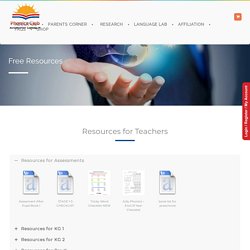
She is working as a trainer and literacy consultant for various organizations. She provides Jolly Phonics and Jolly Grammar training along with the progression of concepts. Resource Bank Archive — Jolly Learning. Free English and maths worksheets and SATs papers for KS1 and KS2. Oxford Owl for School and Home.
Sight Words: Teach Your Child to Read. Incorporating Phonology in Primary ELT – A guide for early career teachers – YLT. Claire Venables As an experienced YL ELT practitioner, I’m aware of how much time and energy is involved in teaching children.

With everything we need to consider in our lessons, in a number of PELT contexts, focusing on phonology sometimes takes a back seat. Many teachers use ‘listen and repeat’ techniques but often give explicit phonology teaching short shrift. There is a prevailing belief that primary children are natural mimics and pick up pronunciation easily, and while this may be true of early years learners, it’s definitely not the case with all primary-aged children.
In this blog post, I’m advocating for a planned approach to the development of children’s phonological awareness and for embedding a regular, systematic pronunciation focus in PELT. Clearly, much phonological work can be done in response to issues teachers identify while monitoring learners’ oral production, much in the same way as for grammar and lexis. Using Phonics in the Efl Classroom – WH Magazine. Any member of the English teaching community has heard the word “Phonics”.
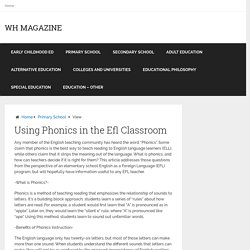
Some claim that phonics is the best way to teach reading to English language learners (ELL), while others claim that it strips the meaning out of the language. What is phonics, and how can teachers decide if it is right for them? This article addresses those questions from the perspective of an elementary school English as a Foreign Language (EFL) program, but will hopefully have information useful to any EFL teacher. A Focus on Phonics. Phonics has been something of a buzzword in the last two schools I have worked in.

I was first introduced to the idea while working at a bilingual international school where it was used with English-speaking primary pupils as a way to introduce them to reading and writing. Although designed for first-language contexts, phonics has a clear appeal to primary ELT practitioners with its step-by-step introduction to sounds associated with each letter useful for reading, spelling, and pronunciation. This is especially true in contexts such as my current one – a language school where the majority of students’ native language is not represented by the Latin alphabet.
With beginner-level young learners needing a high amount of literacy support as they learn to form letters and decode sounds from an alphabet that bears no resemblance to their own, phonics seems to offer an effective solution. However, after experimenting for an extended period, I remain unconvinced. Issue #2 – Abstract concepts. Teaching Phonics to Young Learners. What's All The Fuss About Synthetic Phonics? Let us begin with the most basic question: what exactly is “synthetic phonics”?
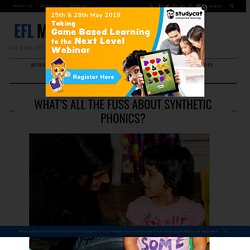
To “synthesize” means to combine parts or elements together. Using the term “to synthesize” in a literacy context therefore means to combine sounds together in order to make words. It is rather like having pieces of a puzzle: isolated and on their own they may not make much sense to us but once we put the pieces of the puzzle together we can then derive meaning from the whole “picture”. As children become familiar with the sounds in a language in order to read words, they also receive instruction on how to listen for and identify specific sounds that supports them when writing and spelling words. Synthetic Phonics vs the “Whole Language Approach”. In the simplest terms, the “whole language approach” encourages children to read by sight rather than sounding out words. This makes learning to read exactly like memorizing the telephone directory.
(Growing a Reader from Birth by Diane McGuinness) Phonics.cz - About Phonics. Introduction to Onestop Phonics. Using Phonics in the Efl Classroom – WH Magazine. Phonics Programme and Alphabetic Code Charts - Free Resources. FREE Resources On this page you will find a wide range of extremely useful free resources for foundational literacy (as pdfs and links to Debbie’s further free resources) for: information, training, guidance, assessment, teaching and learning purposes – in mainstream and intervention contexts.
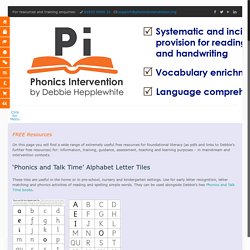
These tiles are useful in the home or in pre-school, nursery and kindergarten settings. Phonics Lesson - How to Structure the Perfect Phonics Lesson! By Shirley Houston on 18 Jun 2018 Your school has bought or created a synthetic phonics program.
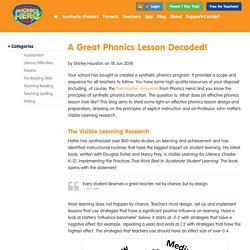
It provides a scope and sequence for all teachers to follow. You have some high quality resources at your disposal (including, of course, the free teacher resources from Phonics Hero) and you know the principles of synthetic phonics instruction. The question is: What does an effective phonics lesson look like? This blog aims to shed some light on effective phonics lesson design and preparation, drawing on the principles of explicit instruction and on Professor John Hattie’s Visible Learning research.
The Visible Learning Research Hattie has synthesized over 800 meta-studies on learning and achievement and has identified instructional routines that have the biggest impact on student learning. Every student deserves a great teacher, not by chance, but by design. Most learning does not happen by chance. John Hattie’s Influence Barometer Organisation The Recommended Phonics Lesson Structure 1. E.g. IH Journal » Phonics in the YL classroom – by Katy Simpson » Print.